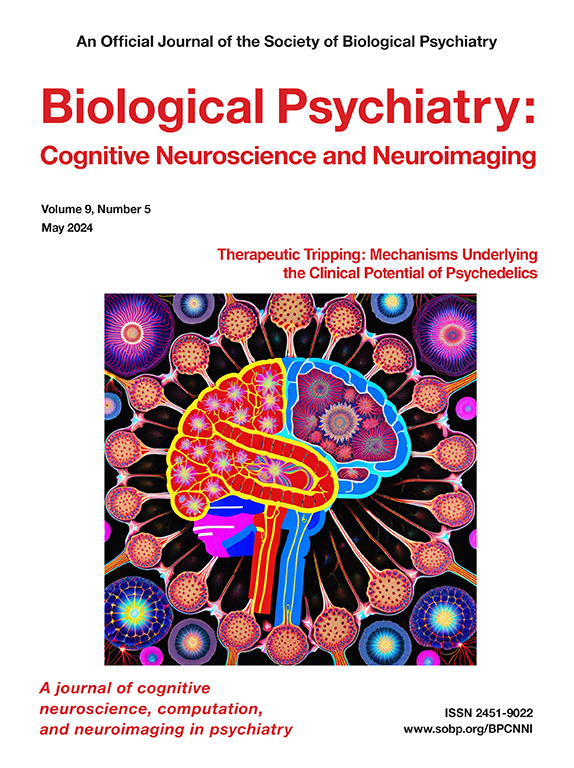自闭症述情障碍假说再访:述情障碍调节自闭症成人面部情感识别过程中的社会脑活动。
IF 4.8
2区 医学
Q1 NEUROSCIENCES
Biological Psychiatry-Cognitive Neuroscience and Neuroimaging
Pub Date : 2025-09-01
DOI:10.1016/j.bpsc.2025.01.007
引用次数: 0
摘要
背景:自闭症谱系障碍(ASD)和述情障碍都与面部情感识别困难(FAR)以及社会大脑活动差异有关。根据述情障碍假说,ASD患者情绪处理的困难可归因于同时发生的述情障碍水平的提高。尽管在行为层面上有大量证据支持这一假设,但在FAR期间,共同发生的述情障碍对大脑功能的影响仍未得到探索。方法:120名完成FAR任务的参与者(60名ASD, 60名对照组)的数据使用功能磁共振成像和行为测量进行分析。该任务包括FAR的显性和隐性测量。自闭症参与者根据他们的述情障碍状态进一步分类。研究了FAR表现和相关脑激活的组间差异。结果:与对照组相比,无论述情障碍状态如何,自闭症参与者的FAR表现都较低。成像显示,在显式FAR期间,与非述情障碍的ASD参与者相比,述情障碍参与者的三个皮层簇的激活程度降低,包括左顶叶下回、楔叶和颞中回。在隐性FAR期间,述情障碍ASD参与者表现出三个皮层簇的激活增加,包括左中央前回、右楔前叶和颞顶叶连接。讨论:我们的研究显示了行为和大脑反应之间意想不到的分离:当ASD影响FAR表现时,只有同时发生的述情障碍才能调节相应的社会脑激活。虽然在行为层面上不支持述情障碍假说,但该研究强调了ASD与共患述情障碍之间的复杂关系,强调了共患条件对理解ASD情绪加工的重要性。本文章由计算机程序翻译,如有差异,请以英文原文为准。
The Alexithymia Hypothesis of Autism Revisited: Alexithymia Modulates Social Brain Activity During Facial Affect Recognition in Autistic Adults
Background
Both autism spectrum disorder (ASD) and alexithymia are linked to difficulties in facial affect recognition (FAR) together with differences in social brain activity. According to the alexithymia hypothesis, difficulties in emotion processing in ASD can be attributed to increased levels of co-occurring alexithymia. Despite substantial evidence supporting the hypothesis at the behavioral level, the effects of co-occurring alexithymia on brain function during FAR remain unexplored.
Methods
Data from 120 participants (60 ASD, 60 control) who completed an FAR task were analyzed using functional magnetic resonance imaging and behavioral measures. The task included both explicit and implicit measures of FAR. Autistic participants were further categorized based on their alexithymia status. Group differences in FAR performance and associated brain activation were investigated.
Results
Autistic participants showed lower FAR performance than control participants, regardless of alexithymia status. Imaging revealed 3 cortical clusters with reduced activation in participants with alexithymia compared with ASD participants without alexithymia during explicit FAR, including the left inferior parietal gyrus, cuneus, and middle temporal gyrus. During implicit FAR, ASD participants with alexithymia showed 3 cortical clusters of increased activation, including the left precentral gyrus, right precuneus, and temporoparietal junction.
Conclusions
Our study shows an unexpected dissociation between behavior and brain response: While ASD affects FAR performance, only co-occurring alexithymia modulates corresponding social brain activations. Although not supporting the alexithymia hypothesis on the behavioral level, the study highlights the complex relationship between ASD and co-occurring alexithymia, emphasizing the significance of co-occurring conditions in understanding emotion processing in ASD.
求助全文
通过发布文献求助,成功后即可免费获取论文全文。
去求助
来源期刊

Biological Psychiatry-Cognitive Neuroscience and Neuroimaging
Neuroscience-Biological Psychiatry
CiteScore
10.40
自引率
1.70%
发文量
247
审稿时长
30 days
期刊介绍:
Biological Psychiatry: Cognitive Neuroscience and Neuroimaging is an official journal of the Society for Biological Psychiatry, whose purpose is to promote excellence in scientific research and education in fields that investigate the nature, causes, mechanisms, and treatments of disorders of thought, emotion, or behavior. In accord with this mission, this peer-reviewed, rapid-publication, international journal focuses on studies using the tools and constructs of cognitive neuroscience, including the full range of non-invasive neuroimaging and human extra- and intracranial physiological recording methodologies. It publishes both basic and clinical studies, including those that incorporate genetic data, pharmacological challenges, and computational modeling approaches. The journal publishes novel results of original research which represent an important new lead or significant impact on the field. Reviews and commentaries that focus on topics of current research and interest are also encouraged.
 求助内容:
求助内容: 应助结果提醒方式:
应助结果提醒方式:


